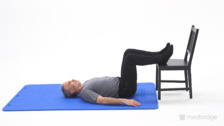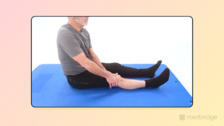Advanced Telehealth Techniques: Evaluation and Intervention
Techniques of the Lower Extremity
Presented by Anna DeLaRosby, Julie Mulcahy, and Todd Norwood
12-Month Subscription
Unlimited access to:
- Thousands of CE Courses
- Patient Education
- Home Exercise Program
- And more
The expansion of telehealth in physical therapy has created new opportunities to assess and treat lower extremity conditions remotely. This course provides clinicians with the essential skills to conduct comprehensive lower extremity evaluations and interventions in a telehealth setting. Participants will learn how to guide patients through remote assessments, including medical screening, range-of-motion testing, and special tests for the hip, knee, ankle, and foot. The course also covers neurological evaluations, strength testing, and evidence-based interventions such as self-mobilization techniques. By the end of this course, physical therapists will be equipped with the knowledge and tools to confidently implement high-quality, patient-centered telehealth care for lower extremity conditions.
Learning Objectives
- Communicate instructions regarding camera view and patient procedure to patients while conducting a telehealth lower extremity examination
- Complete medical screening and triage for the lower extremity
- Demonstrate a thorough remote evaluation of lower extremity range of motion
- Direct the patient through special tests for the lower extremity range of motion
- Instruct the patient in self-joint and/or soft-tissue mobilization techniques of the lower extremity that are suitable for remote delivery
Meet your instructors

Anna DeLaRosby
Anna has been a physical therapist since receiving her doctorate in physical therapy in 2008 and loves all things PT. Anna became certified in mechanical diagnosis and therapy in 2012, and in 2014, she became a board-certified orthopedic clinical specialist. Anna is the clinical program manager for Physera Physical Therapy…

Julie Mulcahy
Julie Mulcahy received her doctorate in physical therapy from the University of Michigan. For the past 20+ years, she has specialized in orthopedics, sports medicine, and women’s health. She obtained her Certificate of Achievement in Pregnancy and Postpartum Physical Therapy (CAPP-OB) in 2021 and her LAMP Institute for…

Todd Norwood
Todd received his doctorate in physical therapy from the University of Southern California and his BA in human biology from Stanford University. He is a board-certified clinical specialist in both orthopedic physical therapy and sports physical therapy and is a fellow of the American College of Healthcare Executives. Todd is…
Chapters & learning objectives

1. Subjective and Objective Assessment
This chapter introduces key strategies for conducting thorough lower extremity evaluations via telehealth. Participants will learn how to effectively communicate camera positioning and examination procedures to patients. The chapter emphasizes the importance of subjective history-taking, symptom behavior analysis, and red flag screening to rule out serious pathology. Objective assessments covered include posture analysis, gait observation, and range-of-motion evaluations for the hip, knee, ankle, and foot. Clinicians will gain strategies for maximizing diagnostic accuracy through structured remote assessments.

2. Objective and Special Tests
This chapter focuses on implementing objective tests and special assessments tailored for telehealth. Participants will learn how to direct patients through functional movement tests, myotome and dermatome assessments, and strength testing using household items for resistance. Special tests for the hip, knee, ankle, and foot will be adapted for remote evaluation, with an emphasis on patient positioning and clear instruction. The chapter highlights best practices for ensuring test reliability and validity in a virtual setting, ensuring that telehealth assessments maintain the same clinical rigor as in-person evaluations.

3. Interventions and Self-Mobilizations
In this chapter, participants will explore telehealth interventions for lower extremity rehabilitation, focusing on self-mobilization techniques and progressive strengthening exercises. Clinicians will learn how to instruct patients in using external tools such as resistance bands, straps, and foam rollers to replicate manual therapy techniques remotely. The chapter covers self-mobilization strategies for the hip, knee, ankle, and foot, with step-by-step guidance to ensure safe and effective patient execution. By integrating these techniques, providers can empower patients to take an active role in their rehabilitation while optimizing telehealth treatment outcomes.
More courses in this series

Advanced Telehealth Techniques: Translating Clinical Skills to Telehealth
Anna DeLaRosby, Julie Mulcahy, and Todd Norwood

Advanced Telehealth Techniques: Evaluation and Intervention Techniques of the Spine
Anna DeLaRosby, Julie Mulcahy, and Todd Norwood

Advanced Telehealth Techniques: Evaluation and Intervention Techniques of the Upper Extremity
Anna DeLaRosby, Julie Mulcahy, and Todd Norwood

Advanced Telehealth Techniques: Evaluation and Intervention Techniques of the Lower Extremity
Anna DeLaRosby, Julie Mulcahy, and Todd Norwood